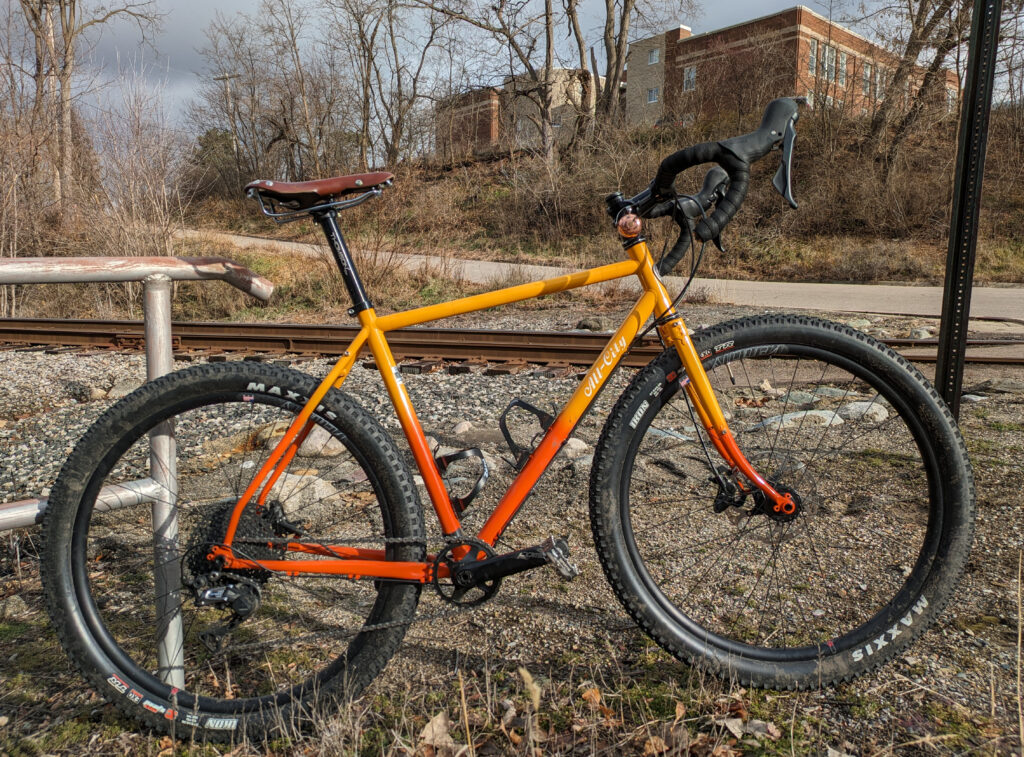
I had been casually keeping my eye out for a 27.5″ plus size gravel bike when a buddy of mine offered to sell me his orange fade All-City Gorilla Monsoon. The bike had a 52cm frame size and at 5’11” (178cm) with an 86cm cycling inseam I figured the bike would be way too small for me. Nevertheless, I couldn’t resist trying out an All-City, and to my surprise the bike actually fit me pretty well. To top things off the bike had been upgraded with a custom built set of Velocity Blunt SS wheels and Maxxis Ikon tires, so at the price I was offered it was a no-brainer.
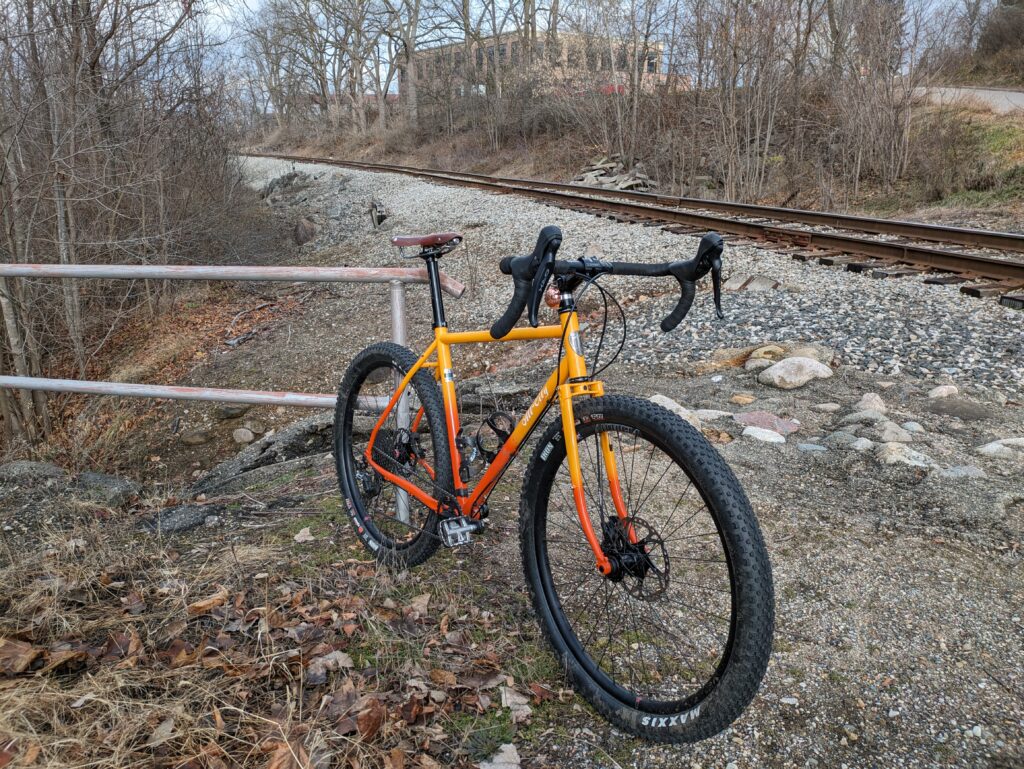
The 52cm All-City Gorilla Monsoon has a reach of 374mm and a stack of 579mm so the bike is a little shorter and significantly lower than my 56T Fairlight Faran 2.0, which has a reach of 382.5mm and a stack of 609.7mm. I think the reason that this works out is because the All-City has a slacker seatpost angle, putting the saddle further back and centering my feet more naturally over the pedals. The drop from the saddle to the handlebars is significant but my arms are fairly long which seems to make up for this, especially because the reach is shorter than the reach on the Fairlight. I have also read that the All-City Gorilla Monsoon feels large for its frame size and I think that my ideal size for this bike is probably a 54cm, but I certainly don’t feel cramped on the 52 and overall I find it to be a very fun, playful and comfortable ride.
In 2021 All-City tweaked the geometry of the Gorilla Monsoon, which theoretically improves the off-road capability of the bike, but unfortunately when they did this they also changed from flat-mount to post-mount brake disc mounts. Even though it is harder to find drop bar brake levers set up to work with post-mount brake calipers as stock, I think that this is a pretty significant negative change because it limits the brake rotor diameter to 160mm (unless you use an expensive workaround such as the 180mm Flat Mount adapter from Peak Torque). This is probably because most hydraulic drop bar shift levers come with flat mount calipers as stock, which is a shame because I believe that larger brake discs make a huge difference to the power and feeling of disc brake systems. As far as I know all road and mountain hydraulic brake calipers within a brand are interchangeable, and there are plenty of cable post-mount brake calipers which are compatible with road levers, so this is less of a concern for custom builds. In my opinion this significantly limits the build possibilities and performance of newer Gorilla Monsoons.
When I bought it this particular Gorilla Monsoon came with an 11-speed Sram Apex groupset, an FSA Comet 1x crankset with a 36-tooth chainring, and TRP Spyre mechanical disc brakes. It also had a generic set of Giant road/gravel handlebars rather than the Salsa Cowchippers which were originally specced with the bike. I found the TRP mechanical disc brakes to work surprisingly well, but decided to upgrade the drivetrain to the 11 speed Shimano GRX groupset off of my Pinnacle Arkose 4, mainly for the hydraulic disc brakes but also for the familiar Shimano shifting action and the brake hood ergonomics. While I was at it I also increased the size of the front disc rotor to 180mm, and installed a smaller 32-tooth chainring for a range of 23.82 to 90.55 gear inches to better fit the bike to my local terrain and riding style. The full current spec of the bike is:
Frame: 612 CroMoly Steel, 142x12mm Thru-Axle, I.S. Brake Mount
Fork: 6130 CroMoly, 15x100mm Thru-Axle, Post Mount Brake Mount
Rear Derailleur: Shimano GRX RD-RX812 1×11
Shift/Brake Levers (Brifters): Shimano GRX ST-RX600 1×11
Bottom Bracket: FSA MegaExo 73mm
Crankset: FSA Comet 1x, 32-tooth Chainring
Cassette: Sunrace 11spd, 11-42t
Brake Calipers: Shimano BR-MT520 4-piston
Brake Discs: Shimano XT SM-RT76-M Center-Lock 180mm Front / 160mm Rear
Handlebars: Giant Alloy Road Bars
Stem: Thomson 10-degree x 90mm
Headset: Cane Creek 40 Series
Bar Tape: Black Cinelli Cork
Rims: Velocity Blunt SS 27.5″, 32 Spokes
Rear Hub: Novatec D772SB
Front Hub: Novatec Generic
Rear Tire: Maxxis Ikon 27.5″x2.35″ 3C MaxxSpeed Exo TR
Front Tire: Maxxis Ikon 27.5″x2.35″ 3C MaxxSpeed Exo TR
Saddle: Velo Orange Model 6 Brown Leather
Seatpost: Thomson Alloy
Pedals: Forte Flat/SPD Combination Pedals
Other: 2x Zefal Bottle Cages, Merida Top Cap Wahoo Mount, Crane Mini Suzu Copper Stem Bell
Drivetrain
This bike originally came with a 36-tooth Chainring and an 11-speed 11-42 cassette, but I thought that this gearing was a little high overall, so I installed a 32-tooth chainring to bring the overall gearing down a little and make climbing more enjoyable.
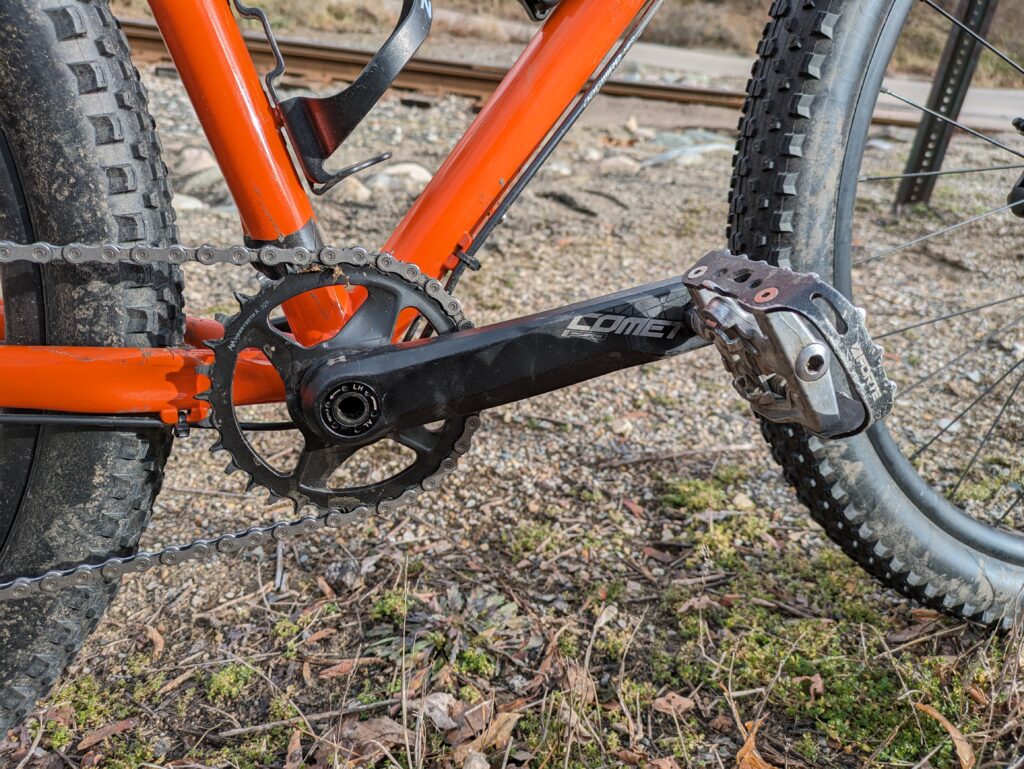
The range of my GRX-based 11-speed drivetrain is fairly limited at 23.82 to 90.55 gear inches and also quite low overall, but I very carefully chose the new chainring to suit my riding style, and I think that it works very well on the flatish terrain of Mid-Michigan. An 11-speed road drivetrain is rather limiting to begin with because the maximum cassette cog size is typically limited by the rear derailleur, but as I already had the GRX drivetrain I opted to adapt it to my style as best as possible rather than upgrade to something like a 12-speed system or implement a mullet drivetrain such as using a bar-end shifter to run a mountain bike derailleur.
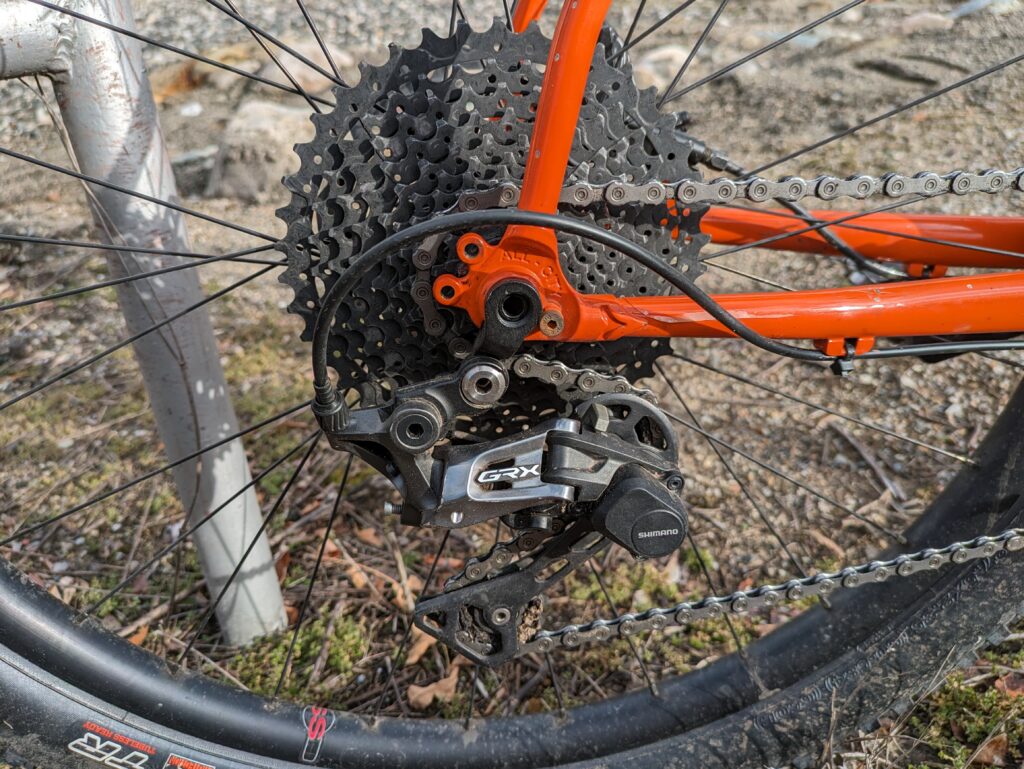
This bike is my only current bike with brifters, which I would not recommend for a touring or bikepacking bike, but I see this as more of a go-anywhere around-town fun bike and the shifters work very well for that. I have found that with this drivetrain I am in the second or third highest gear when pedaling on the flat, with plenty of lower range options for the short hills and climbs I encounter on the mild local off-road trails in mid-Michigan. The bike is probably under geared for long descents, but with coasting always being an option I personally would rather err on the side of gearing that is too low rather than too high.
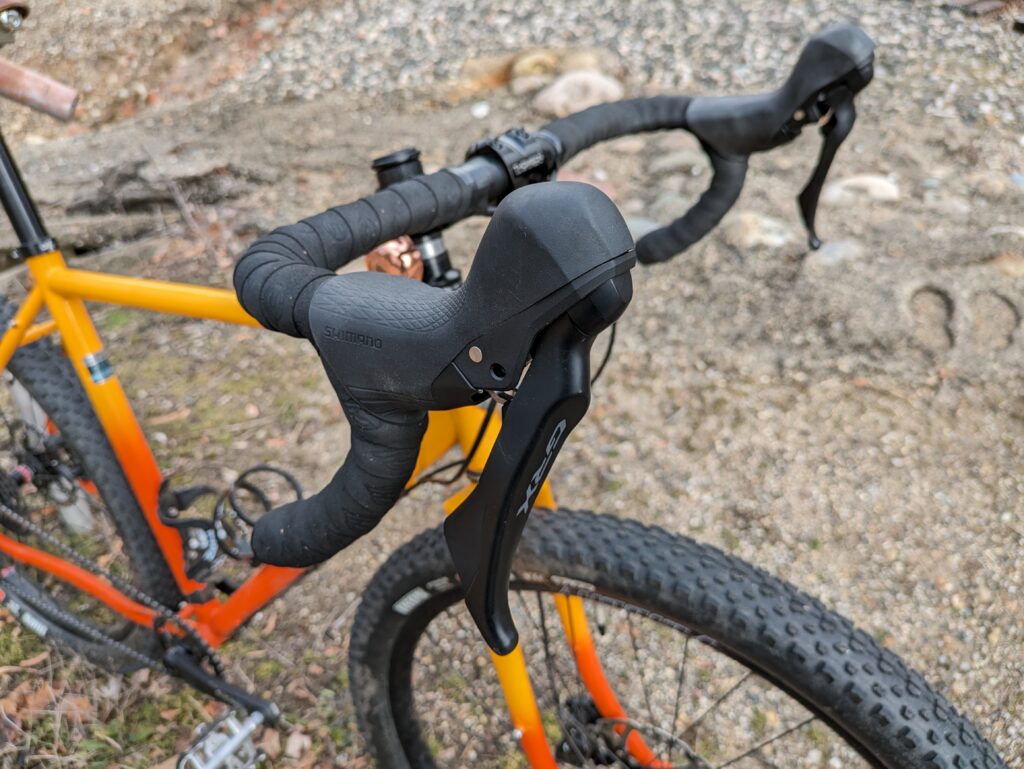
Geometry & Ride Quality
The All-City Gorilla Monsoon is marketed as an ‘adventure bike’, and with the huge tire clearances and rack mounts it is certainly capable of adventure, but my understanding is that it is more akin to a beefed-up cyclocross bike than a gravel or bikepacking bike, which means that this bike has a more aggressive riding position and handling which leans more towards agility than stability. The short chainstays make the bike fun and playful on the climbs, but the head angle is not as slack as a true drop-bar mountain bike like the Surly Grappler, keeping the steering quick and the handling lively. In my opinion this is a wonderful recipe for an all-around fun bike, but I think that this bike would also handle the weight of bikepacking or touring very well. It certainly has the mounts for it, the frame can handle it, and I think that the addition of luggage would increase the stability of the bike and slow the handling down which is exactly what you want when you are carrying a lot of weight.
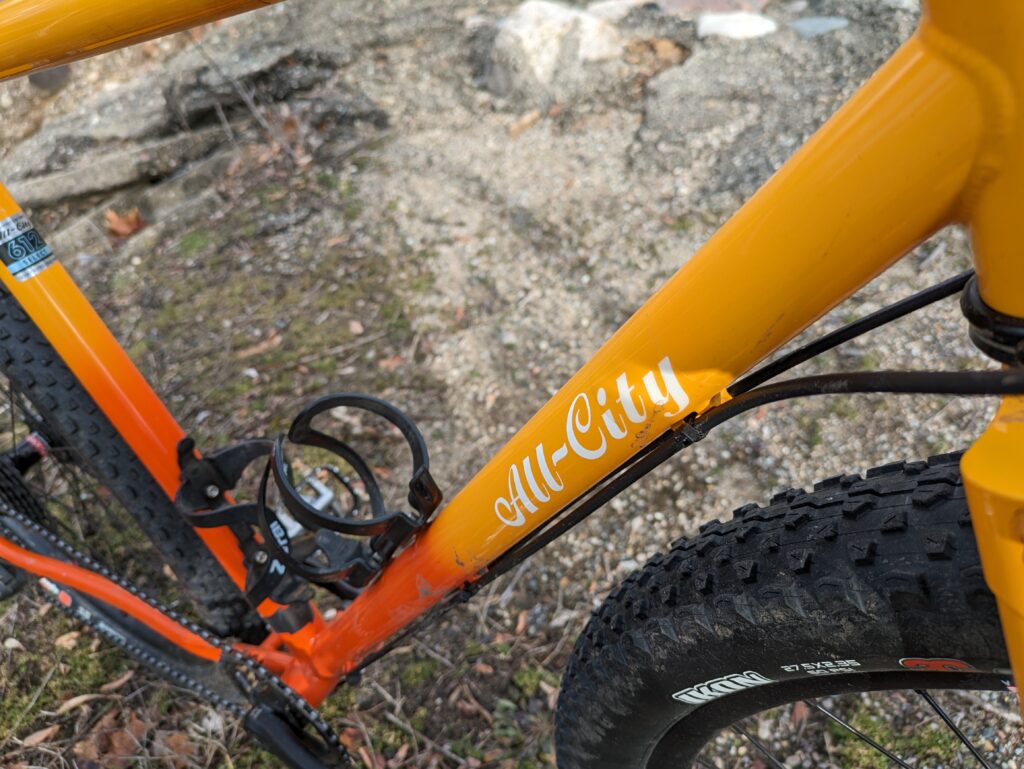
I love the 27.5″ wheel sizing on this bike because there are not many 27.5″ gravel bikes on the market even though in my opinion 27.5″ wheels work better in most situations, especially as tire sizes increase. I think that 27.5″ wheels spin up faster under pedaling and feel livelier overall, and in theory the 27.5″ sizing should allow the geometry of the bike to be more compact, which could add to the lively feel. The Gorilla Monsoon is designed to accept up to 27.5 x 2.4″ tires, which is one of the main things that helps this bike stand out from a lot of other gravel and adventure bikes, especially in the context of the time when this frame was built. Mine has 2.35-inchers, which are capable of rolling over almost anything, but it doesn’t feel like they hold the bike back on smooth pavement either – nice!
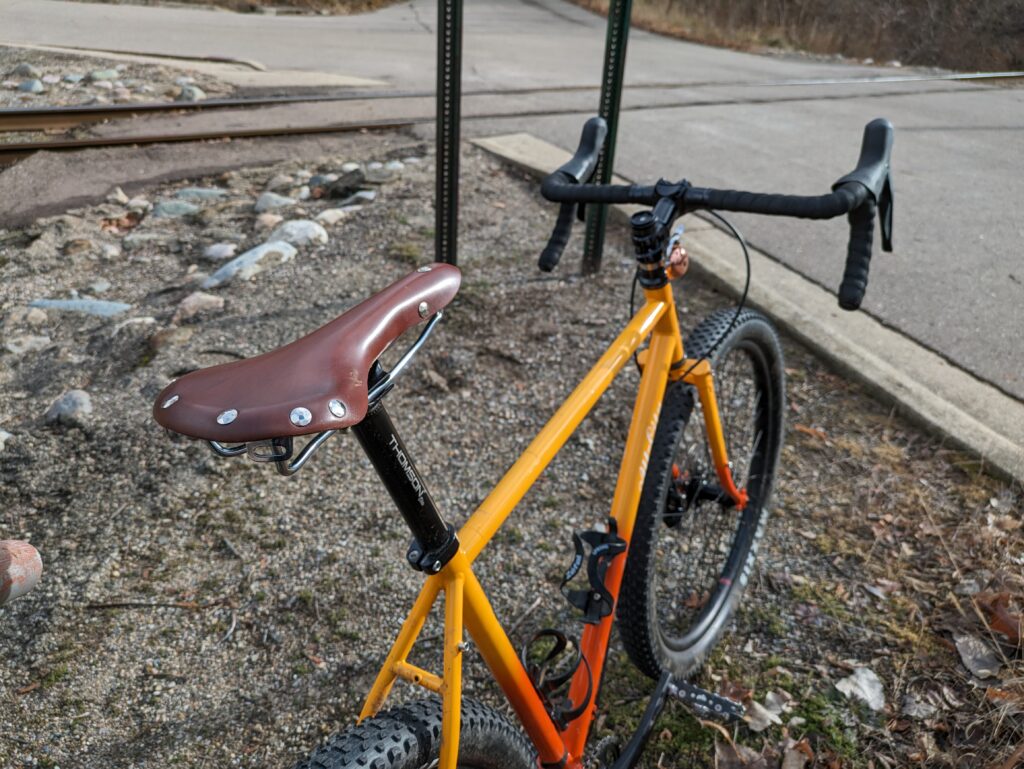
I think that this bike really excels on mixed terrain rides, gravel, double track and smooth, mild single track, and while it is certainly capable of tackling harder terrain, I would much rather have a true mountain bike when the trails get technical. In my opinion flat-bar bikes are more confidence-inspiring when the terrain really gets rough because they tend to have slacker geometry, which increases stability and allows them to roll over obstacles more easily. In addition, flat-bar shifters shift faster, flat handlebars make it much easier to jump or pop the front wheel off the ground, flat bars provide more leverage on the climbs, and true mountain bike gearing is lower, which is much more appropriate for short, technical climbs.
One minor criticism of the Gorilla Monsoon might be that the bike is a little on the heavy side, but it is not excessively heavy considering its capabilities, and despite the weight I think that the bike’s geometry makes it feel lively and responsive. I think that this bike actually rolls and pedals very well, even on the climbs, and it is just a fun bike to grab and go wherever your inspiration takes you. Overall I would say that this is my most well-rounded bike and if I had to have only one bike in my arsenal it would probably be something like this.
Brakes
The TRP Spyre brakes that were originally specced with this bike were the best cable-actuated disc brakes I have ever used. I normally find cable discs to lack both power and modulation, but there was very little in it between the TRP Spyres and the Shimano hydraulic stoppers I replaced them with. It took some finessing to get the BR-MT520 4-piston calipers to work properly with the GRX levers (after doing a gravity bleed I had to add extra fluid to the lines to keep the brake levers from bottoming out against the handlebars), but since figuring out the initial set-up the brakes have been powerful and reliable.
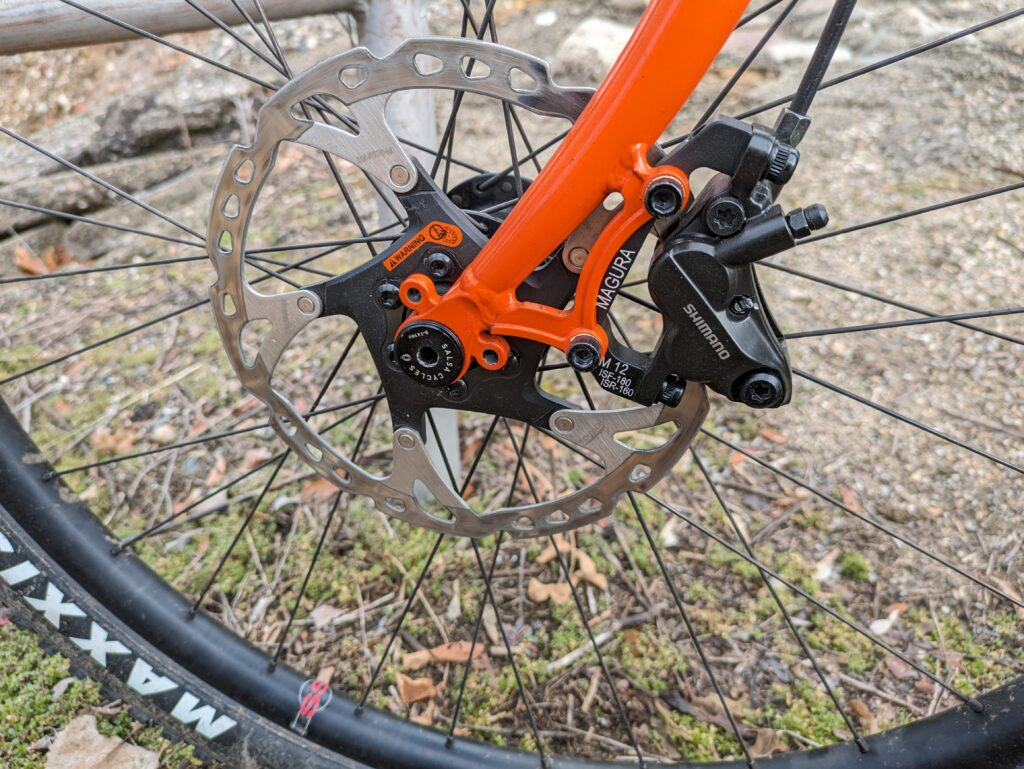
The fact that this bike uses post-mount brakes means that I could use pretty much any size brake discs on this bike, and I opted to upgrade the front brake to a 180mm rotor. I didn’t feel like a 203mm rotor was necessary because I am not planning on riding extreme terrain with this bike, but I always like to err on the size of larger rotors if my frame and brake mount standard accepts them. I think that the larger front rotor significantly improves the modulation and stopping power of the brakes, and it certainly improves heat dissipation, which sounds like a lot of benefits for a very minor weight penalty.
At the end of the day the upgrade from the TRP Spyre cable actuated brakes to Shimano hydraulic brakes had a smaller effect on the performance of this bike than I was expecting, but in general I find hydraulic disc brakes to feel and work better than their mechanical counterparts, and since I was installing Shimano GRX levers anyways I think that the upgrade to the brake system was worthwhile.
Wheels and Tires
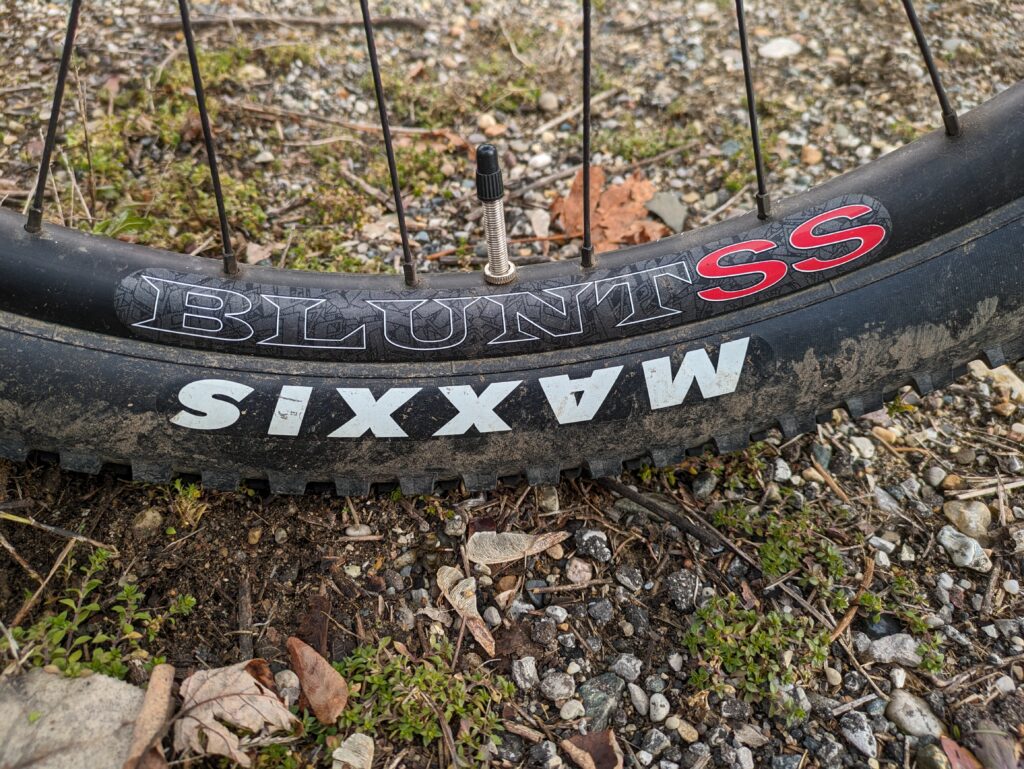
When I got this bike it already had an upgraded wheelset, which is a set of Velocity Blunt SS rims laced to generic Novatec hubs. I was pleased that this was a 32-spoke wheelset for increased robustness over low spoke count 28 or 24 spoke versions, and I have had no problem with the wheelset so far. The tires are Maxxis Ikons, which are very highly regarded cross country mountain bike tires, and I think they are a very good general-purpose choice for a bike like this. They roll well both off and on road, probably aided by the supple 120 tpi thread count in the casing and the 3C Maxxspeed triple compound. I think that the 27.5 x 2.35″ sizing suits this bike well, and I am very happy overall with the wheels and tires on this bike.
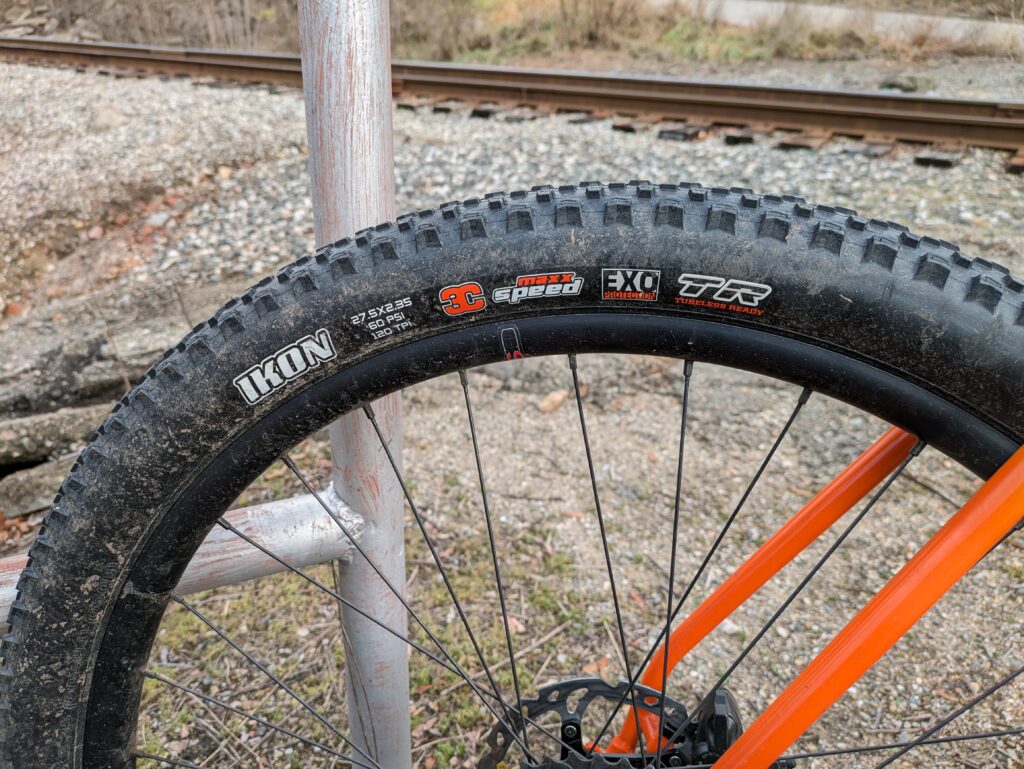
Contact Points
Despite the fact that this bike is a little small for me in theory, I find it to be very comfortable overall. I used the same Cinelli cork bar tape I use on all of my bikes because I think that cork has the most comfort and best balance of firmness and softness of any of the other bar tapes out there, and it is also very affordable. The Velo Orange leather saddle seems to work well with this bike-it is a fairly narrow and race-oriented, but it seems to work with my riding position and the aggressive geometry of this bike. Finally, the pedals are a pair of Forte double-sided flat and SPD pedals, which allow me to use either street or Shimano SPD shoes with this bike without having to swap pedals.
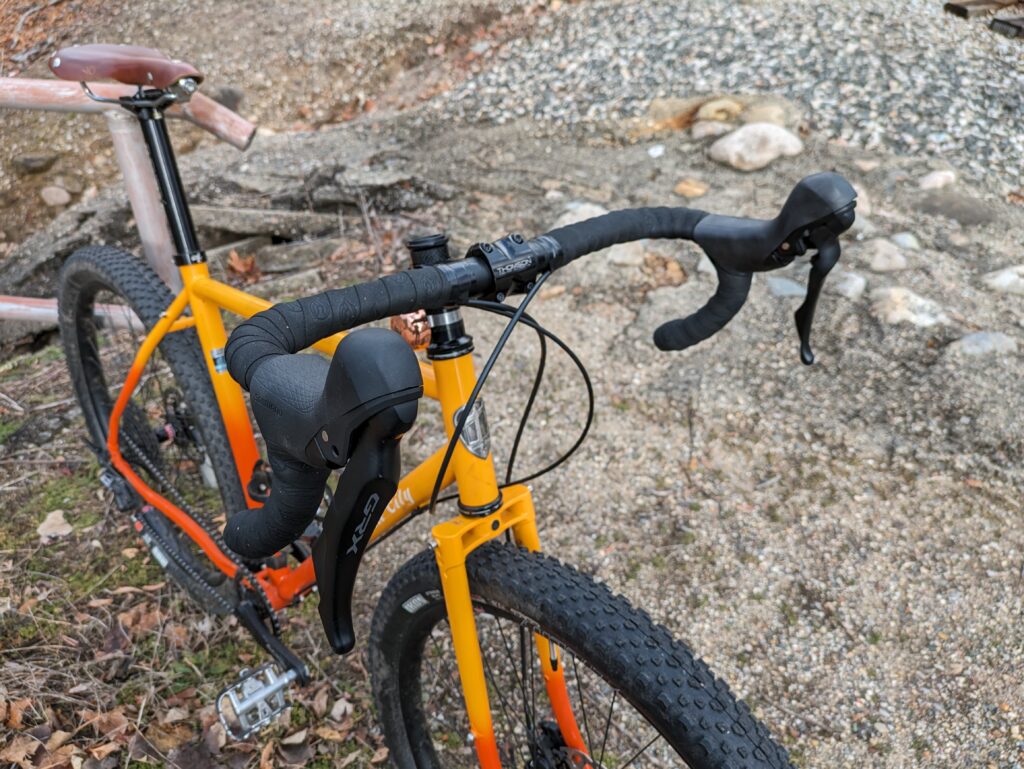
Accessories
I did have a rack on this bike at one point but because this bike is more of a grab it and go adventure type bike I wasn’t really using it so I removed it, and the bike has been pretty bare-bones since then. I did add my favorite bell which is the Crane Mini Suzu headset mount bell in copper, and I also added a couple of cheap and cheerful Zefal plastic spring bottle cages. The final accessory is a Merida top cap mounted attachment point for my Wahoo Elemnt bike computer. Neat, simple, and functional.
Conclusion
Overall I really like my All-City Gorilla Monsoon. It is just a little bit small for me but I think that it is a really fun ride: quick and lively, and capable of working in various types of terrain. I also think that the components I selected are a reasonable choice for this type of bike: the gear ratios work for my riding style, the brakes are effective, and the overall component choice is modern but not too special or unusual. The tires are very good, comfortable and easy-rolling both on and off road, and the 27.5″ wheel size means that the bike pedals easily but is still capable of tacking obstacles and rough patches on off-road adventures. In my opinion this bike strikes a good balance between performance and cost-effectiveness, and it is my weapon of choice if I just want to go out on a generic bike ride, whether around town, on the road, or through a local park or mild trail system.